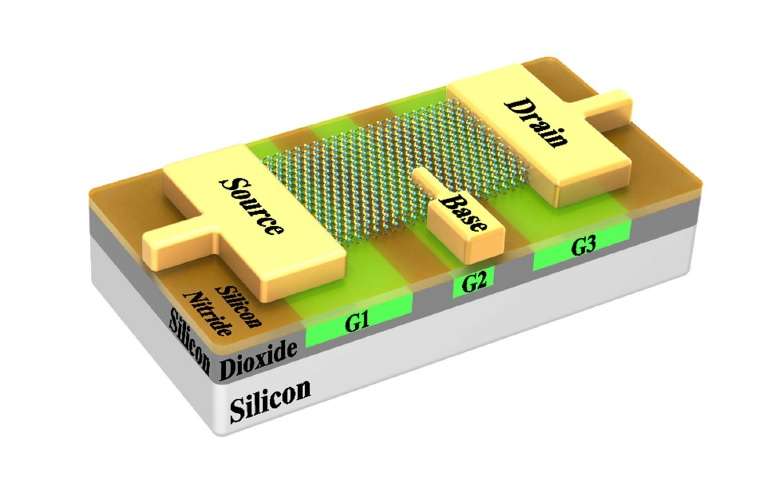June 14, 2017 feature
3-in-1 device offers alternative to Moore's law

In the semiconductor industry, there is currently one main strategy for improving the speed and efficiency of devices: scale down the device dimensions in order to fit more transistors onto a computer chip, in accordance with Moore's law. However, the number of transistors on a computer chip cannot exponentially increase forever, and this is motivating researchers to look for other ways to improve semiconductor technologies.
In a new study published in Nanotechnology, a team of researchers at SUNY-Polytechnic Institute in Albany, New York, has suggested that combining multiple functions in a single semiconductor device can improve device functionality and reduce fabrication complexity, thereby providing an alternative to scaling down the device's dimensions as the only method to improve functionality.
To demonstrate, the researchers designed and fabricated a reconfigurable device that can morph into three fundamental semiconductor devices: a p-n diode (which functions as a rectifier, for converting alternating current to direct current), a MOSFET (for switching), and a bipolar junction transistor (or BJT, for current amplification).
"We are able to demonstrate the three most important semiconductor devices (p-n diode, MOSFET, and BJT) using a single reconfigurable device," coauthor Ji Ung Lee at the SUNY-Polytechnic Institute told Phys.org. "While these devices can be fabricated individually in modern semiconductor fabrication facilities, often requiring complex integration schemes if they are to be combined, we can form a single device that can perform the functions of all three devices."
The multifunctional device is made of two-dimensional tungsten diselenide (WSe2), a recently discovered transition metal dichalcogenide semiconductor. This class of materials is promising for electronics applications because the bandgap is tunable by controlling the thickness, and it is a direct bandgap in single layer form. The bandgap is one of the advantages of 2D transition metal dichalcogenides over graphene, which has zero bandgap.
In order to integrate multiple functions into a single device, the researchers developed a new doping technique. Since WSe2 is such a new material, until now there has been a lack of doping techniques. Through doping, the researchers could realize properties such as ambipolar conduction, which is the ability to conduct both electrons and holes under different conditions. The doping technique also means that all three of the functionalities are surface-conducting devices, which offers a single, straightforward way of evaluating their performance.
"Instead of using traditional semiconductor fabrication techniques that can only form fixed devices, we use gates to dope," Lee said. "These gates can dynamically change which carriers (electrons or holes) flow through the semiconductor. This ability to change allows the reconfigurable device to perform multiple functions.
"In addition to implementing these devices, the reconfigurable device can potentially implement certain logic functions more compactly and efficiently. This is because adding gates, as we have done, can save overall area and enable more efficient computing."
In the future, the researchers plan to further investigate the applications of these multifunctional devices.
"We hope to build complex computer circuits with fewer device elements than those using the current semiconductor fabrication process," Lee said. "This will demonstrate the scalability of our device for the post-CMOS era."
More information: Prathamesh Dhakras, Pratik Agnihotri, and Ji Ung Lee. "Three fundamental devices in one: a reconfigurable multifunctional device in two-dimensional WSe2." Nanotechnology. DOI: 10.1088/1361-6528/aa7350
Journal information: Nanotechnology
© 2017 Phys.org



















